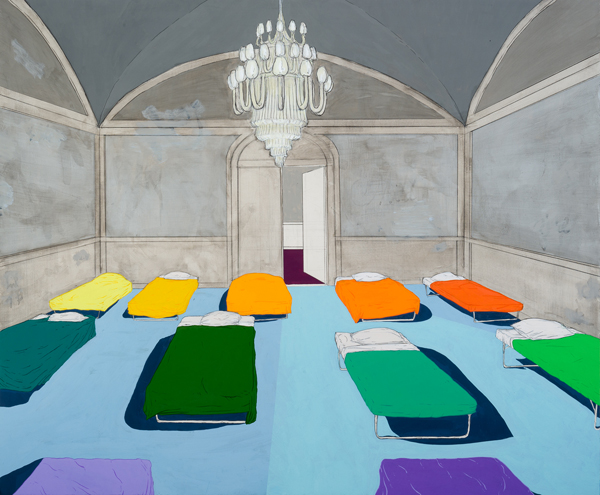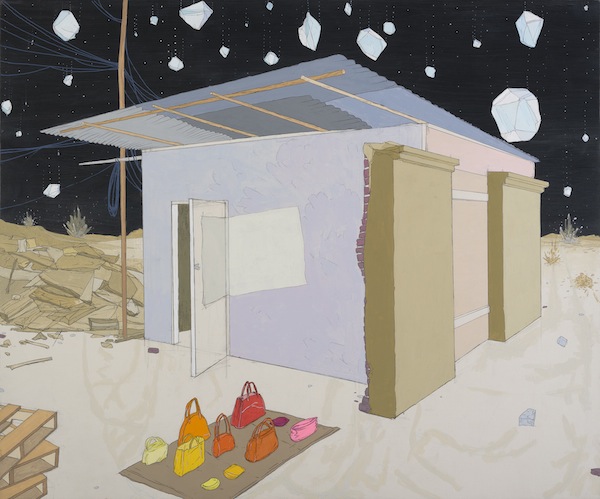At Works On Paper (Philadelphia) through June 1, 2013
The other night I dreamt I was running through an empty, decrepit city: buildings were crumbling onto the street, the pavement was broken up, and there was no one in sight. I was panicked, searching for my wife and ten-month-old son. A group of dangerous looking men blocked my path and surrounded me. As they circled closer I saw more of their group nearby, carrying maimed but living captives, and I somehow understood that these prisoners were being kept as food. I woke up and realized I was dreaming Amze Emmons' current exhibit, Informal City, at Works On Paper in Philadelphia.
Trained as a printmaker, Emmons has an immediately recognizable touch in that medium, characterized by his ability to break apart print language even as it constructs an image. For example, he devised his own recipe for the hard ground used in etching, adjusting the traditional method such that his ground does not perfectly protect the metal plate from the acid bath. As a result, the printing surface becomes pocked and decayed even as the image is formed, and lines have a rough quality. The parallel in Informal City's drawings and paintings is the visibility of leftover preliminary linework, as in Public Knowledge Base (2013), and incongruously colored halos surrounding certain forms (presumably from earlier layers), as in the suitcases in Rollerboard Shelter (2013). The show also includes screenprints on MDF shaped to fit pictures of things like cell phones, disposable cups, and water bottles. These prints are affordably priced, reflecting Emmons' desire to give his art a life outside the realm of luxury goods.

Amze Emmons, Modern Popular Movement, Graphite, gouache, acrylic on panel, 20x24", 2011
It's tempting to call the show post-apocalyptic, but I think that would be a mistake. Modern Popular Movement (2011) looks to me like a reference to the U.S. military's decision to set up shop in Saddam Hussein's presidential palaces during the Iraq war, though given the title and date it more likely points to the Libyan revolution. Emmons stages his scenes in ruined urban environments that compare to today's Syria, yesterday's Iraq, and also resemble blighted areas of Philadelphia. The shanties, stolen electricity, and water tanks he portrays are a global phenomenon fueled by refugee crises and extreme poverty, and the environmental havoc implied by an image like The Lost Pageant (2008) is already well underway. We never see the inhabitants of Informal City, so we know little about them beyond their need to survive after civil society has evaporated.

Amze Emmons, Ghost Cargo, Graphite, gouache, acrylic on canvas, 20x24", 2013
Emmons generally delivers his harsh visions in candy colors, which may be a strategy to help the medicine go down, but also points to consumer culture as one source of our problems. His color comes from things like plastic toys, low-end advertising, and commercial packaging. Ghost Cargo (2013) drives the point home with its colorful collection of handbags on display outside a makeshift dwelling that looks unlikely to survive the large chunks of ice falling from the sky.
This review was originally published in Title Magazine on May 10, 2013